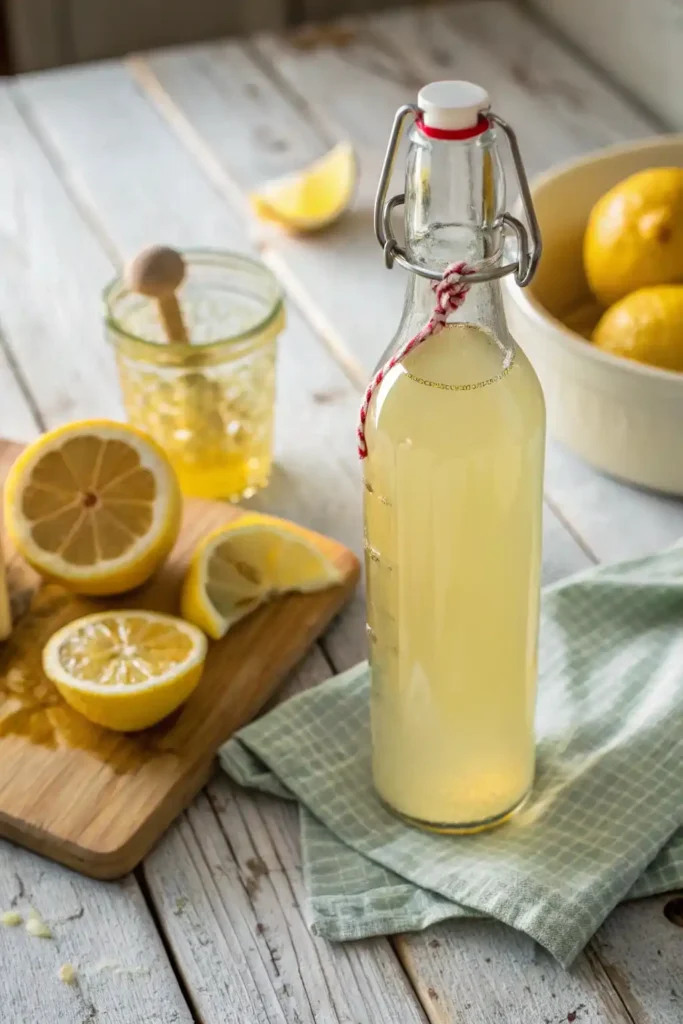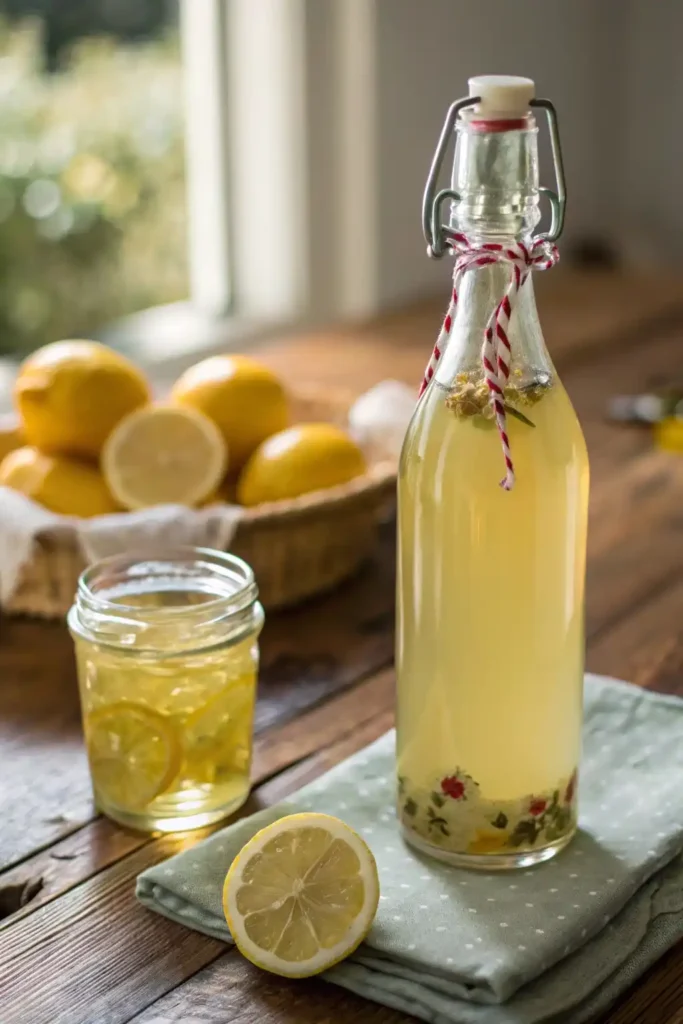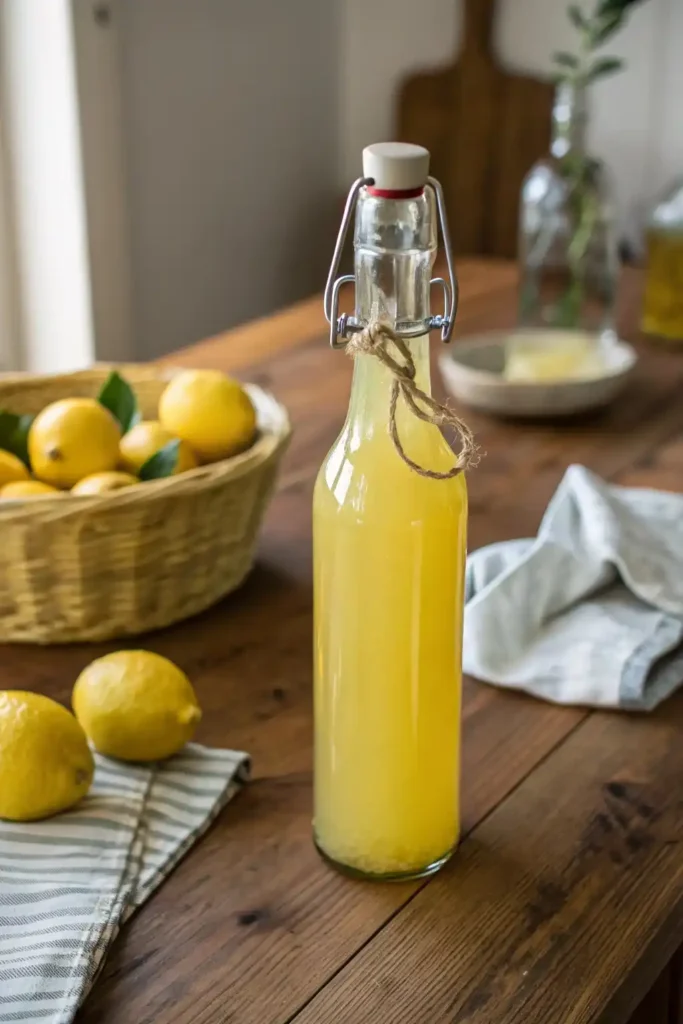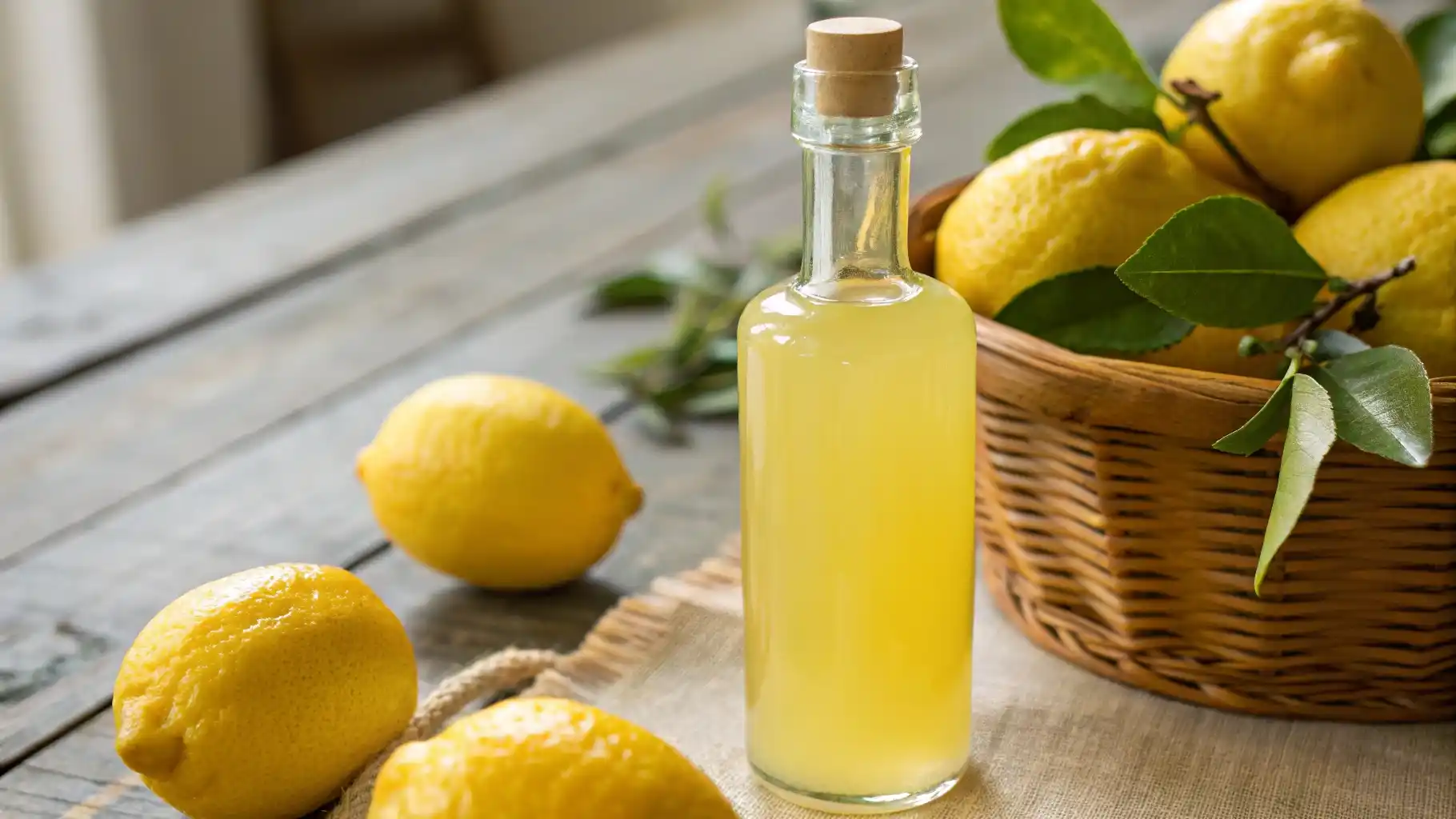Limoncello holds a special place in Italian culture as the country’s second most cherished liqueur after Campari. This bright yellow digestif, served chilled after meals throughout the Amalfi Coast, delivers a perfect balance of sweet citrus flavors that brighten any dining experience.
Creating authentic limoncello at home requires just three basic ingredients: organic lemons, high-proof alcohol, and sugar. The recipe yields about 2.5 liters of liqueur. While patience plays a key role – the process typically spans 2-4 weeks – properly stored homemade authentic limoncello keeps well in the freezer for up to a year.
The smooth, sweet flavor profile makes limoncello ideal for both special occasions and thoughtful handmade gifts. A bottle of homemade authentic limoncello brings the essence of Italian hospitality to any gathering.
Let’s explore this traditional recipe step by step, transforming simple ingredients into a cherished Italian digestif.
The Story Behind Authentic Italian Limoncello

Three charming towns along the Amalfi Coast – Amalfi, Sorrento, and Capri – each claim to be limoncello’s true birthplace. While debates continue about its origins, one fact remains clear: the extraordinary lemons of this region define authentic limoncello’s character.
Roots in the Amalfi Coast
Lemon cultivation near Minori, a small village close to Amalfi, dates back to the 7th century according to Culinaria Italy. The region’s unique microclimate and fertile soil helped develop special lemon varieties perfect for limoncello production.
Three distinct origin stories paint the picture of authentic limoncello’s birth:
- Capri’s Tale: The most documented account traces to early 1900s Capri. Maria Antonia Farace made lemon liqueur from her garden fruits for guesthouse visitors. Her grandson later served this family recipe at his restaurant. The commercial story began when her great-grandson, Massimo Canale, registered the “Limoncello” trademark in 1988.
- Sorrento’s Version: Local tradition places limoncello’s origins earlier, with wealthy families serving their special lemon liqueur to guests in the early 1900s. The Massa family claims creating the recipe in the 1890s, leading to Villa Massa’s establishment in 1991.
- Amalfi’s Account: The oldest claim suggests Medieval origins, with farmers and fishermen drinking lemon-based alcohol to ward off morning chills. Some say sailors used it to prevent scurvy. Another theory credits monks who created the liqueur “to preserve the pleasures of life between prayers”.
British journalist Lee Marshall offers a different perspective. His research shows no documented limoncello consumption before the early 20th century, suggesting its widespread popularity emerged mainly after 1988.
Two special lemon varieties stand at the heart of authentic limoncello:
Sfusato Amalfitano: These elongated Amalfi Coast lemons feature intense aromatics and thick, flavorful peels.
Femminello (or Ovale di Sorrento): These Sorrento lemons now carry Protected Geographical Indication status from the European Union.
These lemons’ thick peels contain rich essential oils creating limoncello’s distinctive character. Traditional cultivation methods use chestnut poles to protect the coastal terraced gardens. Lemon trees flourish throughout the region – along coastlines, roads, private gardens, and balconies.
The transformation from local specialty to global phenomenon happened remarkably fast. While families made lemon liqueur for generations,authentic limoncello’s international popularity exploded only in the past thirty years.
Italy’s Ministry of Agriculture and Forestry now requires authentic limoncello to use citrus specifically from Campania’s Sorrento region and Amalfi Coast.
Authentic Limoncello’s Role as a Digestif

Limoncello serves as a digestivo in Italian dining culture – a drink that aids digestion after meals. This bright, refreshing liqueur perfectly concludes meals while celebrating “the Italian custom of enjoying a long meal and time with friends”.
The digestif tradition formalized in the early 1800s when wine merchants created special after-dinner liqueurs. Lemons’ natural digestive properties made authentic limoncello an ideal fit.
Amalfi Coast restaurateur Carlo Mansi emphasizes timing, recommending lemon-based digestifs within 30 minutes after eating. Beyond digestion,authentic limoncello plays a vital role in Italian hospitality. As bartender Calabrese notes, “When you go to somebody’s house, the first thing they would offer you is coffee. And if you say no to coffee, they would bring out a bottle of liqueur and put it on the table. There is nothing more beautiful than a great lemon liqueur”.
Proper serving requires specific elements:
- Chilled temperature, often straight from the freezer
- Some establishments use ice-coated glasses
- Traditional stemmed glasses about three inches tall
- Served after lunch or dinner, rivaling coffee’s importance
Modern variations include mixing with soda water or incorporating into cocktails. For Amalfi Coast residents,authentic limoncello represents regional pride and heritage, “telling the story and culture of the Amalfi Coast”.
Traditional production demands “time and care”, with families passing down unique recipe variations. Whether created by “a citrus-grove tender from Azzurra around 1900 or by monks or fishermen much earlier”, limoncello captures Mediterranean sunshine in liquid form.
While homemade versions outside Italy cannot perfectly match those using Sorrento or Amalfi lemons, they honor this cherished tradition. Simple ingredients – lemon peels, alcohol, sugar, and water – transform into a drink embodying Italian hospitality and the Amalfi Coast’s vibrant spirit.
Essential Ingredients for Authentic Limoncello
True Italian limoncello celebrates simplicity. Three basic ingredients, when carefully selected and combined with patience, create the bright yellow digestif known for its silky texture and intense citrus flavor.
Unlike other spirits demanding rare botanicals or special equipment, limoncello relies purely on ingredient quality. Each component serves a specific purpose in developing the liqueur’s distinctive character. The right combination yields approximately 2.5 liters of homemade limoncello.
The success of your limoncello depends entirely on choosing these three ingredients wisely. While commercial versions often cut corners, authentic homemade limoncello demands attention to each element’s quality and proper proportions.
Essential Ingredients for Authentic Limoncello Recipe
Choosing Your Lemons
The character of your limoncello depends entirely on lemon quality. Two Italian varieties traditionally define authentic limoncello:
- Sfusato Amalfitano: These elongated Amalfi Coast lemons offer thick, aromatic peels and surprisingly low acidity. Local residents often eat them like apples.
- Sorrento Lemons: Known as “Ovale di Sorrento,” these medium to large lemons provide highly acidic juice and essential oil-rich peels.
Meyer lemons make an excellent substitute for home brewers outside Italy. These citron-mandarin hybrids create aromatic authentic limoncello with a slightly orangey profile. Standard grocery store lemons work too, though selection becomes even more critical.
Organic Lemons Matter: Choose organic, unwaxed lemons for three essential reasons:
- Alcohol extracts everything – including pesticides from conventional farming
- Wax coatings block essential oil release
- Chemical residues create bitter flavors
“What is really mandatory is that you choose organic lemons“.
Avoiding Bitter Pith: Remove only the yellow peel, avoiding white pith underneath:
- Use a sharp vegetable peeler or zester
- Trim away any remaining pith with a paring knife
- Try a Microplane for finely shredded zest

Start your authentic limoncello within 48 hours of purchasing lemons. Some makers prefer spring harvest lemons, typically April and May, before summer heat intensifies.
Selecting Your Alcohol
Traditional Italian limoncello uses pure grain alcohol (95% ABV). “This is the only authentic way to prepare authentic limoncello: no vodka, no other distilled liquors are used in Italy to make it”.
High-proof alcohol offers clear advantages:
- Better essential oil extraction
- Fresher flavor
- Shorter steeping time
- Proper freezing consistency
In the United States, Everclear provides a common substitute. When high-proof alcohol proves unavailable, vodka works with these adjustments:
- Choose highest proof possible (100-proof ideal)
- Extend steeping time (3-4 weeks versus 3-14 days)
- Adjust sugar ratios accordingly
“While high-proof alcohol will extract enough flavor in a matter of days, peels steeped in 80-proof liquor will need to rest for an entire month”.
Your alcohol choice affects appearance too. Everclear sometimes creates cloudy limoncello while high-proof vodka yields clearer results. For proper freezer storage, final alcohol content should reach at least 30% ABV.
Balancing Sugar and Water
Simple syrup determines sweetness, texture, and final alcohol strength. Traditional Italian ratios target specific strengths:
- 37% ABV: 1 liter water, 600g sugar, 1 liter 95% alcohol
- 29% ABV: 1.4 liters water, 830g sugar, 1 liter 95% alcohol
Adjust sugar levels to taste:
- More sugar creates traditional sweetness
- Less sugar highlights citrus flavors
Meyer lemon versions often use 1:3 sugar-to-water ratios. Others prefer 1:4 for balanced flavor.
Even syrup temperature matters. Warm syrup typically creates cloudy limoncello, while cool syrup yields clearer results.
The perfect balance weighs several factors:
- Alcohol preserves lemon flavor but adds bite
- Sugar smooths texture but can mask citrus
- Water softens harshness but affects storage
Start with basic ratios, then adjust future batches to taste. “Much of that depends on personal taste, whether you like your limoncello on the sweeter side or not”.
Homemade limoncello improves with age. Most versions reach peak flavor after 1-3 months in storage, making patience as important as any ingredient.
Making Authentic Limoncello Step by Step
Quality ingredients transform into golden limoncello through four careful stages. The techniques remain straightforward, making this Italian classic achievable in any home kitchen.
Preparing Your Lemons
Clean lemons thoroughly before zesting:
- Scrub with rough sponge under running water
- Dry completely with clean towel
- Check for and discard any damaged fruit
Two reliable methods remove zest while avoiding bitter pith:
Traditional Peeler Method:
- Hold lemon firmly
- Remove thin strips with sharp vegetable peeler
- Trim away white pith with paring knife
Microplane Technique:
- Hold grater in one hand, lemon in other
- Gently rasp yellow skin only
- Stop at first sight of white pith
The Microplane creates finely shredded zest that “needs less steeping time due to the total surface area exposed to the alcohol”.
Remember: “Take just the yellow part, the white is bitter”. Place zest directly into clean glass container with tight lid.
Infusing the Alcohol
Pour chosen alcohol over zest and store container:
- Away from heat
- Protected from sunlight
- In undisturbed location
Infusion times vary by alcohol strength:
- 95% ABV grain alcohol: 15-30 days
- 40% ABV vodka: 30-45 days
- Microplaned zest may infuse faster
“If you remember, shake the jar every day”. Watch for these signs of completion:
- Vibrant yellow color develops
- Peels turn brittle and snap easily
- Lemon oil aroma intensifies
- Zest becomes pale
“When liquor is yellow in color and peel begins to turn white and easily snaps in two pieces when bent, limoncello is done”.
Creating the Simple Syrup
While waiting for infusion, prepare sugar syrup:
- Combine water and sugar in heavy saucepan
- Heat gently, stirring occasionally
- Dissolve sugar without boiling
- Remove from heat
- Cool to room temperature
“When making the simple syrup ensure the water does not come to a boil. Light bubbles, even before it simmers is the perfect time”.

Some makers note: “Add the infused alcohol when the syrup is still warm, as it will give you a lovely yellow authentic limoncello. If the syrup is too cold, the color will be lighter”.
Filtering and Bottling
First Filtering:
- Line fine-mesh strainer with cheesecloth
- Strain infused alcohol
- Press zest gently
- Mix with cooled syrup
Second Filtering (recommended):
- Rest mixture 24 hours
- Filter again through coffee filters
- This step “will remove even more residual solids and result in a smoother final product”
Bottling Steps:
- Clean glass bottles thoroughly
- Rinse with boiling water
- Dry completely
- Fill using funnel
- Seal tightly
Let bottled limoncello mature 30 days minimum. “Letting the limoncello rest will allow the flavors to meld together and become smoother”.
Before serving, chill thoroughly in freezer. “We use to drink the limoncello well cold. Store one bottle in the fridge and the rest in a dry and fresh place”.
For best results, “We also love to put the empty limoncello glass in the freezer for half an hour before serving”.
Patience throughout this process yields authentic Italian limoncello worth sharing with friends and family. While commercial versions offer convenience, homemade limoncello delivers unmatched satisfaction through careful crafting and aging.
Final Notes
Quality ingredients and patient crafting yield limoncello worthy of Italian tradition. Organic lemons, high-proof alcohol, and precise sugar ratios form the foundation of this bright digestif. Each careful step honors generations of Italian families who perfected this beloved recipe.
The golden liqueur demands attention to detail – from gently peeled citrus to properly chilled serving glasses. While commercial versions offer convenience, homemade limoncello delivers unmatched satisfaction through mindful preparation and aging.
Store bottles in the freezer for ideal serving temperature. The silky texture and vibrant lemon notes shine brightest when poured ice-cold into chilled glasses. This careful serving method highlights the weeks of patient crafting invested in each batch.
Each new preparation offers chances to refine techniques and adjust flavors. Whether shared after dinner or given as gifts, properly made authentic limoncello captures Mediterranean sunshine in liquid form. The reward comes in sharing this handcrafted digestif with friends and family, creating moments of authentic Italian hospitality in your own home.
FAQs
Q1. What are the key ingredients needed to make authentic Italian limoncello? Authentic Italian limoncello requires just three main ingredients: organic lemons (preferably Sfusato Amalfitano or Sorrento varieties), high-proof neutral alcohol (95% ABV grain alcohol is traditional), and sugar for making simple syrup.
Q2. How long does the limoncello infusion process typically take? The infusion process typically takes 15-30 days when using high-proof grain alcohol (95% ABV), or 30-45 days minimum when using lower-proof vodka (40% ABV). The duration may vary based on the alcohol strength and zest preparation method.
Q3. Can I use regular lemons from the grocery store to make authentic limoncello? While traditional Italian lemons are ideal, you can use organic, unwaxed lemons from the grocery store. Meyer lemons make an excellent substitute if available. The most important factor is choosing organic lemons to avoid pesticides and wax coatings that can affect the flavor.
Q4. How should I store homemade authentic limoncello and how long does it last? Store your homemade limoncello in the freezer for the best taste and texture. When properly made and stored, it can last up to a year. Keep one bottle in the refrigerator for serving and the rest in a cool, dark place.
Q5. What’s the best way to serve homemade authentic limoncello? Serve limoncello ice-cold in chilled glasses to enhance its silky texture and bright flavors. For an extra touch, place empty limoncello glasses in the freezer for about 30 minutes before serving. Traditionally, it’s enjoyed as a digestif after meals.

